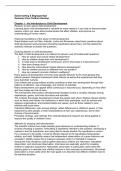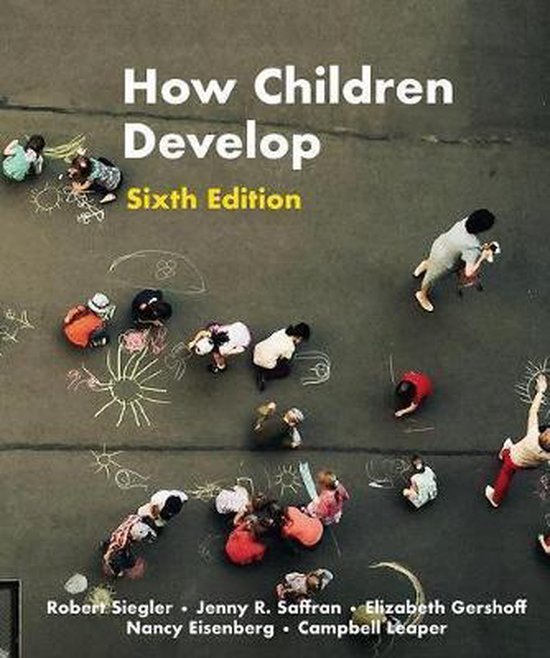Samenvatting & Begrippenlijst
Summary How Children Develop
Chapter 1 – An Introduction to Child Development
Reasons to learn about child development
Learning about child development is valuable for many reasons: it can help us become better
parents, inform our views about social issues that affect children, and improve our
understanding of human nature.
Historical foundations of the study of child development
Great thinkers such as Plato, Aristotle, Locke and Rousseau raised basic questions about
child development and proposed interesting hypotheses about them, but they lacked the
scientific methods to answer the questions.
Enduring themes in child development
The field of child development is an attempt to answer a set of fundamental questions:
1. How do nature and nurture shape development?
2. How do children shape their own development?
3. In what ways is development continuous, and in what ways is it discontinuous?
4. How does change occur?
5. How does the sociocultural context influence development?
6. How do children become so different from one another?
7. How can research promote children’s wellbeing?
Every aspect of development, from the most specific behavior to the most general trait,
reflects people’s biological endowment (their nature) as well as the experiences that they
have had (their nurture).
Even infants and young children actively contribute to their own development through their
patterns of attention, use of language, and choices of activities.
Many developments can appear either continuous or discontinuous, depending on how often
and how closely we look at them.
The mechanisms that produce developmental changes involve a complex interplay among
experiences, genes, and brain structures and activities.
The contexts that shape development include the people with whom children interact directly,
such as family and friends; the institutions in which they participate, such as schools and
religious organizations; and societal beliefs and values, such as those related to race,
ethnicity and social class.
Individual differences, even among siblings, reflect differences in children’s genes, in their
treatment by other people, in their interpretations of their own experiences, and in their
choices of environments.
Principles, findings, and methods from child-development research are being applied to
improve the quality of children’s lives.
Methods for studying child development
The scientific method has made possible great advances in understanding children. It
involves choosing a question, formulating a hypothesis relevant to the question, developing a
method to test the hypothesis, and using data to decide whether the hypothesis is correct.
For a measure to be useful, it must be directly relevant to the hypotheses being tested,
reliable, and valid. Reliability means that independent observations of a given behavior are
consistent. Validity means that a measure assesses what it is intended to measure.
Among the main situations used to gather data about children are interviews, naturalistic
observation, and structured observation. Interviews are especially useful for revealing
children’s subjective experience. Naturalistic observation is particularly useful when the
primary goals is to describe how children behave in their everyday environments. Structured
observation is most useful when the main goals is to describe how different children react to
the identical situation.
,Correlation does not imply causation. The two differ in that correlations indicate the degree to
which two variables are associated, whereas causation indicates that changing the value of
one variable will change the value of the other.
Correlational designs are especially useful when the goal is to describe relations among
variables or then the variables of interest cannot be manipulated because of technical of
practical considerations.
Experimental designs are especially valuable for revealing the causes of children’s behavior.
Data about development can be obtained through cross-sectional designs (examining
different children of different ages), through longitudinal designs (examining the same
children at different ages), or through micro-genetic designs (presenting the same children
repeated relevant experiences over a relatively short period and analyzing the change
process in detail).
It is vital for researchers to adhere to high ethical standards. Among the most important
ethical principles are striving to ensure that the research does not harm children physically or
psychologically; obtaining informed consent from parents and, where possible, from children;
preserving participants’ anonymity; and correcting any inaccurate impressions that children
form during the day.
Chapter 2 – Prenatal development and the newborn period
Prenatal development
Nature and nurture combine forces in prenatal development. Much of this development is
generated by the fetus itself, making the fetus an active player in its own progress.
Substantial continuity exists between what goes on before and after birth in that infants
demonstrate the effects of what has happened to them in the womb.
Prenatal development begins at the cellular level with conception, the union of an egg from
the mother and a sperm from the father to form a single-celled zygote. The zygote multiplies
and divides on its way through a fallopian tube.
The zygote undergoes the processes of cell division, cell migration, cell differentiation, and
cell death. These processes continue throughout prenatal development.
When the zygote becomes implanted on the uterine wall, it becomes an embryo. From that
point, it is dependent on the mother to obtain nourishment and oxygen and to get rid of waste
products through the placenta.
Fetal behavior begins 5 or s6 weeks after conception with simple movements, undetected by
the mother, that become increasingly complex and organized into patterns. Later, the fetes
practices behaviors vital to independent living, including swallowing and a form of intrauterine
“breathing”.
The fetus experiences a wealth of stimulation both from within the womb and from the
external environment. The fetus learns from this experience, as demonstrated by studies
showing that both fetuses and newborns can discriminate between familiar and novel
sounds, especially in speech, and exhibit persistent taste preferences developed in the
womb.
Hazards to prenatal development
There are many hazards to prenatal development. The most common fate of a fertilized egg
is spontaneous abortion (miscarriage).
A wide range of environmental factors can be hazardous to prenatal development. These
include teratogens from the external world and certain maternal characteristics, such as age,
nutritional status, physical health, behavior (especially the use of legal or illegal drugs), and
emotional state.
The birth experience
Approximately 38 weeks after conception, the baby is ready to be born. Usually, the behavior
of the fetus helps to initiate the birth process.
Being squeezed through the birth canal has several beneficial effects on the newborn,
including preparing the infant to take his or her first breath.
, Cultural practices surrounding childbirth vary greatly and are in part related to the goals and
values emphasized by the culture.
The newborn infant
Newborns’ state of arousal range from deep sleep to active crying.
The amount of time infants spend in the different arousal states varies greatly, both across
individuals and across cultures.
REM sleep seems to compensate for the lack of visual stimulation that results from the
darkness of the womb, and for the fact that newborns spend much of their time with their
eyes shut, asleep.
The sound of a baby crying can be very aversive, and adults employ many strategies to
soothe distressed infants.
The infant mortality rate in the United States is high relative to that of other developed
countries. It is much higher for babies born to low-SES parents.
Infants born weighing less than 5½ pounds (2500 grams) are referred to as being of low birth
weight. LBW infants are at risk for a variety of developmental problems, and the lower the
birth weight, the greater the risk of lasting difficulties.
A variety of intervention programs have been designed to improve the course of development
of LBW babies, encompassing time in the hospital as well as after the infant returns home.
The multiple-risk model refers to the fact that infants with a number of risk factors have a
heightened likelihood of continued developmental problems. Poverty is a particularly
insidious risk to development, in part because it is associated with numerous negative
factors.
Some children display resilience even in the face of substantial challenges. Resilience
seems to result from certain personal characteristics and from responsive care from
someone.
Chapter 3 – Biology and behavior
Nature and nurture
The starting point for development is the genotype – the genes inherited at conception from
one’s parents. Only some of those genes are expressed in the phenotype, one’s observable
characteristics. Whether some genes are expressed at all is a function of dominance
patterns. Most traits studies by developmental scientists are influences by multiple genes.
The eventual outcome of a given genotype is always contingent on the environment in which
it develops. Parents and their behavior toward their children – which is influenced by the
parents’ own genotypes – are a salient part of the children’s environment. Similarly, the
child’s development is influenced by the aspects of the environment he er she seeks out and
the different responses the child’s characteristics and behavior evoke from other people.
Epigenetic effects – the switching on and off of genes – underlies many aspects of
development and individual differences. This process is affected by experiences via
methylation.
Behavior genetics
Behavior genetics is concerned with the joint influence of genetic and environmental factors
on behavior. Quantitative behavior geneticists use a variety of family-study designs to
generate heritability estimates, examining the relative contributions of heredity and
environment for individual differences for a range of traits and behaviors in a population.
Molecular behavior genetics approaches permit the field to move beyond family designs to
investigate patterns of genes across large groups of people.
Brain development
Neurons, the basic units of the brain’s informational system, transmit information between the
brain and body via electrical signals. The brain’s cortex is composed of several major areas,
or lobes, specialized for different functions.






